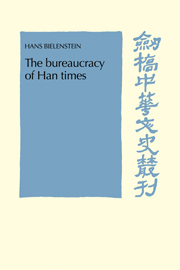Book contents
- Frontmatter
- Contents
- List of tables
- Preface
- Chronological table of emperors
- Abbreviations
- 1 The sources
- 2 The central administration
- 3 The local administration
- 4 The army
- 5 The salaries of the officials
- 6 Civil service recruitment
- 7 Power in government
- 8 Conclusion
- Notes
- Appendix: Official titles of the Han dynasties, Chinese–English
- Quoted literature
- Index
- Frontmatter
- Contents
- List of tables
- Preface
- Chronological table of emperors
- Abbreviations
- 1 The sources
- 2 The central administration
- 3 The local administration
- 4 The army
- 5 The salaries of the officials
- 6 Civil service recruitment
- 7 Power in government
- 8 Conclusion
- Notes
- Appendix: Official titles of the Han dynasties, Chinese–English
- Quoted literature
- Index
Summary
This book has attempted to show how the bureaucracy was organized in Han times, how the officials were recruited, and how power was wielded. Han government was based on the principle that no one should have unlimited authority, and that all actions, including those of the emperor, should be open to scrutiny. Starting as a compromise between a centralized government and feudal domains, Han China developed into a purely bureaucratic state under central control. In that process, the system proved its fundamental stability and the capacity to adapt itself and grow. The bureaucracy gradually evolved on the one hand toward greater maturity and sophistication. On the other, it underwent three major rapid adjustments. In 144 B.C., the government confirmed the reorganization of the bureaucracy, following the uprising and defeat of the Seven Kingdoms, by a change in official titles. The reign of Emperor Wu (140–87 B.C.) witnessed important bureaucratic innovations, which in 104 B.C. culminated in another sweeping change of nomenclature. This was done on the occasion when a new calendar was adopted and a new era was thought to begin. The third reorganization occurred in the reign of Emperor Kuang-wu (25–57), founder of the Later Han.
The total size of the bureaucracy, from the Chancellor down to the Accessory Clerks, is recorded as being 130,285 men in 5 B.C. No corresponding figure has been preserved for Later Han. It ought to have been lower, since more than 400 prefectures were abolished from A.D.
- Type
- Chapter
- Information
- The Bureaucracy of Han Times , pp. 156 - 157Publisher: Cambridge University PressPrint publication year: 1980



